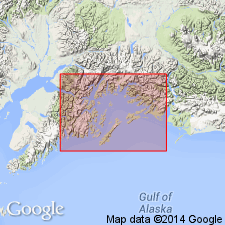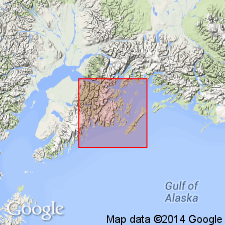
- Usage in publication:
-
- Esther granite*
- Modifications:
-
- Named
- Dominant lithology:
-
- Granite
- AAPG geologic province:
-
- Alaska Southern region
Summary:
Occupies greater part of Esther Island at south end of Port Wells, northwest Prince William Sound, southern AK. Is one of two largest granite masses near sound. Composed of gneissic granite which is in most places slightly porphyritic. Many aplitic dikes extend from granite into surrounding sedimentary deposits which are much sheared and metamorphosed. Cuts Valdez group. [Age is Mesozoic(?)].
Source: GNU records (USGS DDS-6; Menlo GNULEX).

- Usage in publication:
-
- Esther Granite*
- Modifications:
-
- Age modified
- Geochronologic dating
- AAPG geologic province:
-
- Alaska Southern region
Summary:
K-Ar age on biotite yielded 35.5 +/-0.9 Ma (Lanphere, 1966). Sample collected on east shore of Esther Lake, 60 deg 50'N, 148 deg 03"W. Unit included in plutons of central Seward quad; map legend shows age as Oligocene.
Source: GNU records (USGS DDS-6; Menlo GNULEX).
For more information, please contact Nancy Stamm, Geologic Names Committee Secretary.
Asterisk (*) indicates published by U.S. Geological Survey authors.
"No current usage" (†) implies that a name has been abandoned or has fallen into disuse. Former usage and, if known, replacement name given in parentheses ( ).
Slash (/) indicates name conflicts with nomenclatural guidelines (CSN, 1933; ACSN, 1961, 1970; NACSN, 1983, 2005, 2021). May be explained within brackets ([ ]).

